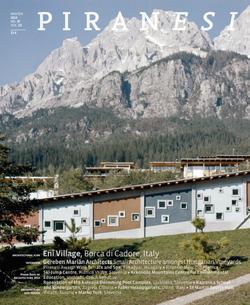
Piranesi no. 37/Vol. 23/ 2015 (COver: Eni Village by Edoardo Gellner)
Editorial / Piranesi 46/47
The Dialectic of Piranesi
Luka Skansi
From the first copies of Piranesi to today, as we leaf through its 55th issue, the world has changed radically, and so has the “system of architecture”. The need for an architectural magazine, a space in which the work of architects, urban planners and designers is presented in the context of a critical approach to the discipline, its topics and its challenges, has been reduced to a minimum. The new media, new intensity of information, new forms of presence and the need for notoriety among architects have drastically shifted, if not displaced, the traditional channels through which architectural culture was expressed and presented in the past.
Ten, fifteen years ago, magazines in the paper format were still the key, sometimes exclusive medium for learning about architectural production and thought, as well as the ideas of critics and historians. They were a space in which syntheses of processes and theories were presented, in which tastes, languages, and sensibilities were manifested, in which the expansion of influences, fashion, tendencies could be perceived. They were the first step by which architecture and architectural thought left their authors to become the subjects of public debate. After all, without the “architectural magazine” as a medium, we simply cannot imagine the development of architecture in the twentieth century, and especially not of modernism as such.
For better or worse, this is no longer the case today. All over the world we are witnessing the closing down of countless editorial and publicist projects. And a progressive bowing down to new forms of online knowledge transfer, which – though at first sight offering openness and global accessibility of information – actually produces a genericity of messages conveyed by architectural forms, and an acriticism, because the web as a medium is not (yet) capable of the material and immaterial contextualisation and treatment of architecture. It remains to be seen what and how much we will pay for this dispersion of critique and methodologies of communication. The only thing that can be established today is the inevitable end (which does not necessarily mean defeat) of one model, a system that will not return.
In this context, we ask ourselves – in parallel with the appropriate reverence of Piranesi’s long and successful editorial experience – what could be the future of our magazine? What is the point of publishing an architectural magazine in times when the form has lost all legitimacy? Does Piranesi, in its conceptual roots, still have any relevance, any critical position in today’s world?
There is perhaps only one thought that can capture all these questions, and that is that Piranesi, in its original format, can only be understood in the context from which it was born. It addresses a specific geographical area (from the Alps to the Adriatic and the Pannonian Plain), it presents one cultural and therefore implicitly political position towards the present (the need for identification in a broader, transnational – though far from global – architectural context), it offers one clear declaration on the role of architectural history (as a methodological and conceptual support for the contemporary architectural project, with a strong emphasis on the evolution of modernism). In this sense, the architects and architectures featured in this journal over the decades have never spoken the same explicit language but spoke about one implicit conceptual approach to design. A concept based precisely on this problematic but necessary dialectic between the territory and its necessary transformation, between the context and its re-formation.
Thirty years after the first issue and a few years after the first Piran Days of Architecture – which gave rise to the cultural platform of the magazine – the reasons for reiterating such an approach are definitely different. But despite geopolitical shifts and changes in the professional situation, the Piranesi formula still makes sense. It can be seen as traditional, and a superficial look might even see it as reactionary. But a formula based on dialectics is by definition always modern, anti-nostalgic, whatever the context in which it is expressed.





